
Ceramic tiles are brittle and prone to cracking. To cut through ceramic tile, you will need a power tool with an abrasive blade.
Fortunately, a jigsaw with an abrasive carbide (or diamond) edge can cut ceramic tile cleanly and safely – plus it can make notches, slanted cuts, and openings that few other power tools can.
TIP!
It is important to note when using a jigsaw to cut tile it should be used for smaller, more intricate cuts and not your "main cutting tool".
Even though it is possible to cut full tiles with a jigsaw, there are better tools that can do the job much better and much more efficient.
Items Needed To Cut Ceramic Tiles (With A Jigsaw):
Of course, you will need a jigsaw. In this case, it won’t even need to have an orbital action option, since any extra vibration will hamper rather than help the jigsaw blade as it tries to cut into the ceramic tile.
Blades: Typical jigsaw blades, with their sharpened teeth, will cause the tile to crack and break apart. The blade you need to use is an abrasive carbide edge blade, or a diamond blade.
They look very similar but use different materials in their abrasives and the cost is also varied. Check out the images below from Home Depot to get a feel for how similar they really look.
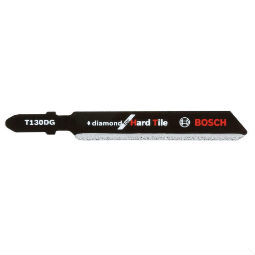
Diamond Jigsaw Blade

Carbide Jigsaw Blade
Measuring & Marking: Just like with all jigsaw cuts, you will often need to mark out accurate cutting lines.
You will need your tape measures when measuring the length and width of your workpiece and speed square if you want to do square cuts.
If you want to go for curved cuts across one or more tiles, you will also need a beam compass or a template.
Drill And Drill Bit: If you need to start a cut in the interior, you will need a drill with a glass tile or ceramic bit to make a starter hole inside the tile.
You will also need starter holes for the corners and sharp turns of your design, as well.
Coolant: Remember that you will have to lubricate and cool the blade as it makes the cut. You can either have a squirt bottle handy to give the blade a squirt of water every now and then, or you can have a hose running a bit of water along the surface of the tile.
Using a coolant is optional and really just makes the blade last a little bit longer. You don't have to use a coolant if you don't want to.
Use extreme caution when using any type of power tool and water together. It can be very dangerous!
Clamps: You will need to have a way to securely clamp the tile to an elevated work surface, with enough clearance for the jigsaw blade to move up and down.
Protection: Finally, you will need to put on eye protection and a face mask to protect yourself from the ceramic dust ejected in the process of cutting the tiles.
How to Cut Straight Lines In Ceramic Tile
TIP!
Making notches, angled cuts or square cutouts is typically the most common "straight cuts" you will make on ceramic tile using a jigsaw but the basic principles apply for cutting all of them.
To cut a square or angled cut in ceramic tile, first use a straightedge to mark the cut line on the ceramic tile that will guide your cut.
To help you make longer cuts an opening that will span several tiles, it will help if you first lay out the tiles in the order that they go on the work area.
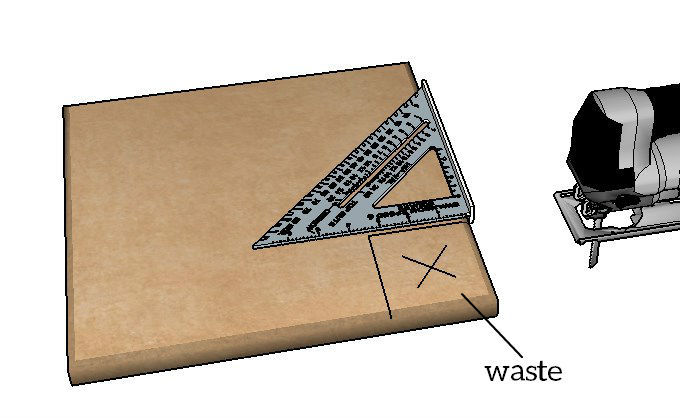
mark tile with cut lines
Label or number the tiles to keep track of their order and orientation. It helps to also mark the waste side with an X, especially if you are marking several tiles at once.
Install a carbide edge or diamond edge blade on your jigsaw, making sure that it’s one that is designed for ceramic tile.
These blades use a grinding instead of a chiseling action to make the cut, which lets them safely work on brittle materials.
To safely cut ceramic with a jigsaw, it’s crucial that the workpiece is secured well. Secure the tile between two wood blocks or MDF boards that are clamped tightly on to a workbench or a saw horse, with the cutting line suspended.
Check that there’s enough clearance for the jigsaw blade to work with.
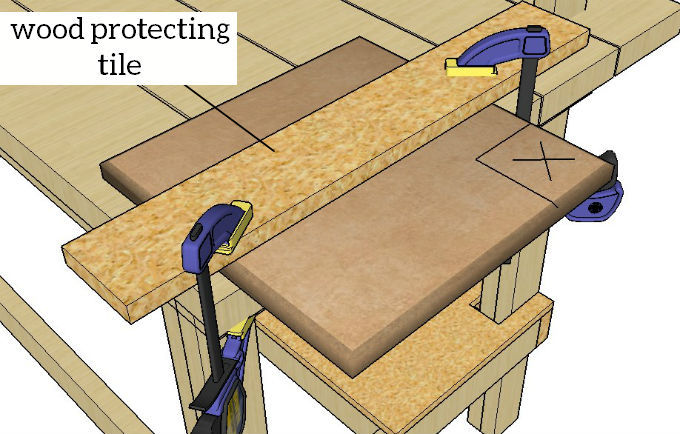
Clamp Tile To Workbench
It helps if the cutting line is as close to the workbench or saw horse as possible to minimize chattering and vibration.
After drawing your outline, turn on your jigsaw and set it on low speed and wait for the jigsaw blade to gain speed.
The moment that your jigsaw blade is up to speed, slowly cut your way through the ceramic tile until you finish your cut.
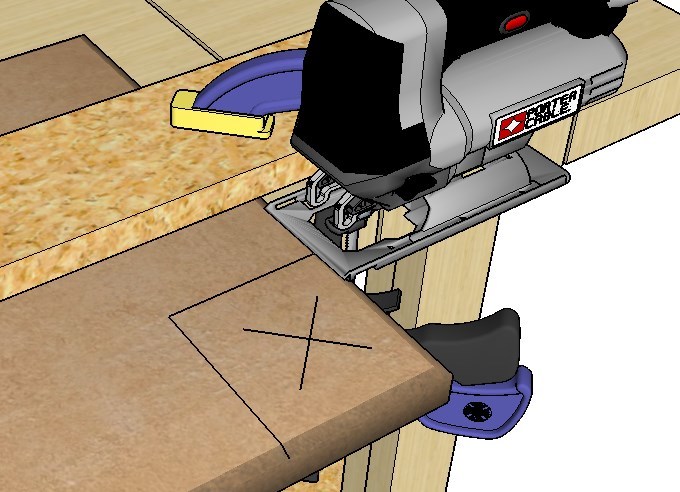
Focus on following the cutting line, and let the abrasive jigsaw blade do the work. Keep the cut cooled and lubricated with a little bit of water to keep the blade cooled and clean during the process.
Be careful with water and power tools! A cutting oil will also work for this and help keep the blade cool.
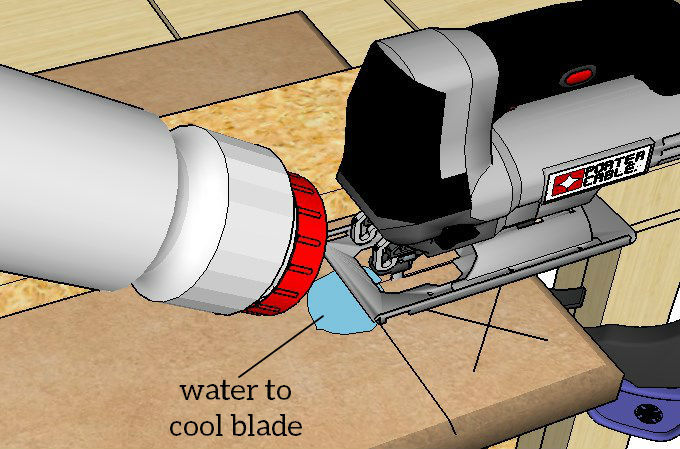
How to Do an Interior Cut in Ceramic Tile Using a Jigsaw
Interior cuts in ceramic tile are often done to cut out openings for wall outlets and taps. To do an interior cut in tile, you will need a power drill, a drill bit and a jigsaw.
Mark out the area that you want to cut out and place an "X" inside of that area to make it clear what side of the line your blade is goint to cut on. Then, attach a glass or ceramic bit on the power drill.
Some bits have a cutting spade-shaped tip, while others come with carbide tipped ends.
Below are three examples from Home Depot's website that show the different types of drill bits that are made for drilling a pilot hole through tile.
Make sure that the bit will leave a hole large enough for the jigsaw blade to fit through.

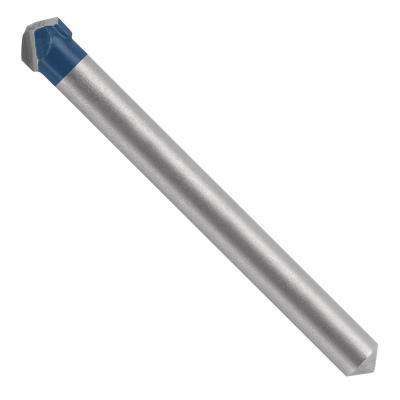
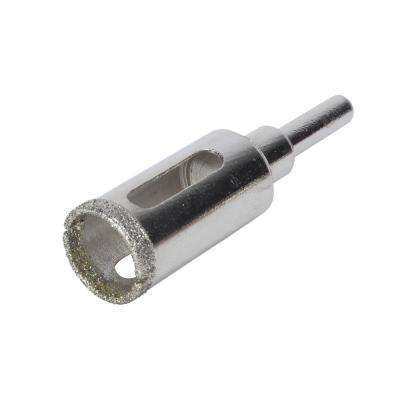
Make sure the tile is secured tightly before making any of the starter holes so it doesn't move on you while you are drilling.
Drill a starter hole in the waste side of the cutting line for every other corner of the cut you wish to make. If you are cutting out a rectangle, for example, you will need at least two starter holes (at opposite ends) for all the corners of the cut.

Drill Pilot Holes For Interior Tile Cutouts
The rounded edges of the starter holes also mean that the tile is much less prone to cracking on the corners.
Take the jigsaw and position the blade inside the starter hole, while making sure that the blade follows the cutting line and that the shoe is flat against the tile surface. Start the tool, and let the jigsaw blade get up to speed.
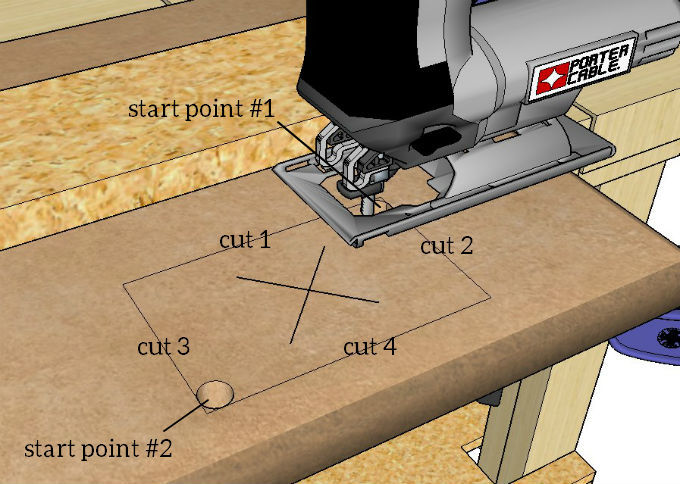
Ease the running blade against the tile workpiece, and focus on following the cutting line – let the blade do the work.
Make sure that the blade and the tile stay cool by either squirting some water periodically on the cut or by doing the cut under a small amount of running water.
How to Cut Curved Lines In Ceramic Tile
To cut curved lines in ceramic tile using a jigsaw, for a shorter, thinner carbide jigsaw blade with a medium or high grit. These are also used for hardened material such as glass and marble.
Cutting out general curves are pretty much the same process described above and there is really no difference in procedure, you will just pay closer attention to the blade and make sure it stays within your cut line.
While cutting, focus on following the cutting line – let the abrasive grit do the work of removing the material.
For tight corners, you may have to add pilot holes in order to make the turn.
The more sharp turns that your design has, the more starter holes you’ll need to put in. You can also use these holes to cut relief lines to make cutting out intricate designs easier.

